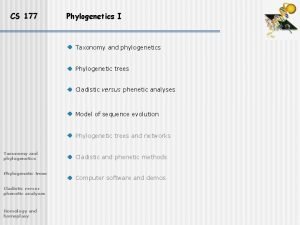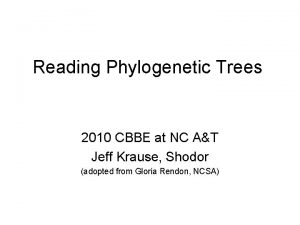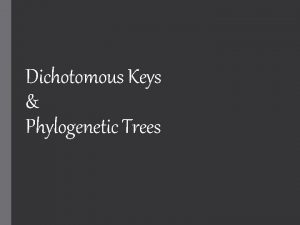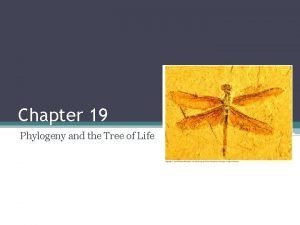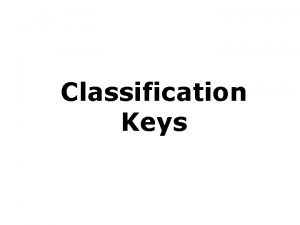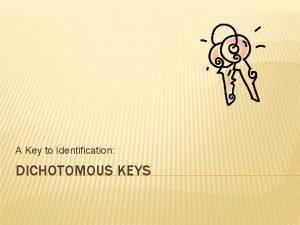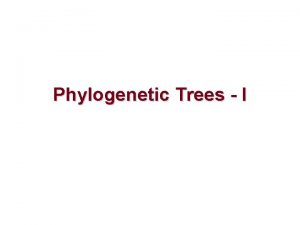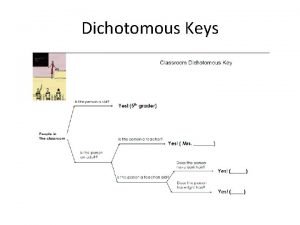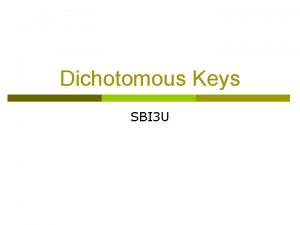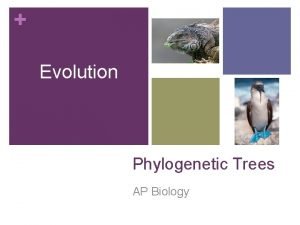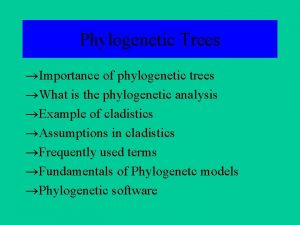Dichotomous Keys Phylogenetic Trees What if we find















- Slides: 15

Dichotomous Keys & Phylogenetic Trees

What if we find things we don't know and we want to know what they are? We use dichotomous keys to identify organisms

Dichotomous Keys A dichotomous key is a tool that allows the user to determine the identity of items in the natural world based on the items characteristics "Dichotomous" means “divided into two parts” Greek origin dichotomous keys always give two distinct choices in each step, often they are opposites Black/white; good/evil; pointed/rounded

How to use a dichotomous key?

How to use a Dichotomous Key? • Choose one organism • Start at step 1 • Always read both choices • Decide which choice is true • Then follow the directions of the true statement • Keep going until you come to a step that gives you the organisms name

Let’s try it!!! Using the dichotomous key on the next slide, identify the following organisms

1. a. wings covered by an exoskeleton – go to step 2 b. wings freely observed – Go to step 3 2. a. body has a round shape ………. ladybug b. body has an elongated shape ………. grasshopper 3. a. wings point out from the side of the body ………. dragonfly b. wings point to the posterior of the body ………. housefly

Did you get the correct answers? Dragonfly housefly ladybug grasshopper

Evolutionary History • Phylogeny - evolutionary history of a species or a group of related species. • Phylogenetic Tree – diagram that biologists use to predict the evolutionary relationships of organisms Organized based on evidence as well as taxonomy Constructed to make the simplest relationships possible

Phylogenetic Trees • Classifies organisms into major taxa (groups) based on evolutionary relationships. • Classifies species in the order in which they descended from a common ancestor using physical characteristics. • Trees can show order of species divergence from the common ancestor and some even more specifically show time of divergence.

Phylogenetic Trees • From a phylogenetic tree we can learn: Which groups are most closely related Which groups are least closely related Which group diverged first (longest ago)

How to Read them • Speciation - branching of a family tree • Extinction - loss of one of the branches. • Start from the “trunk” – this always represents a common ancestor that all organisms on the tree evolved from • Each node represents a more recent common ancestor

How NOT to Read them • They do not show that A B C D Ex. Bacteria Amoeba Insect Trout Human and Bird is NOT correct • They do not show A > B > C > D Ex. Humans are not greater than trout which is not greater than insects…. etc.

Which two organisms are more closely related? chimpanzees and new world monkeys or chimpanzees and old world monkeys

Chimpanzees and old world monkeys!! Even though they LOOK farther away from each other on the phylogenetic tree, they actually share more branches than the chimpanzees and new world monkeys
 Biological classification pogil answers model 4
Biological classification pogil answers model 4 Rooted scaled tree
Rooted scaled tree Phylogram vs cladogram
Phylogram vs cladogram King phillip came over from germany swimming
King phillip came over from germany swimming Dichotomous keys should be read from step 1.
Dichotomous keys should be read from step 1. What is a dichotomous key? *
What is a dichotomous key? * Biodiversity classification
Biodiversity classification Dichotomous keys are constructed based on
Dichotomous keys are constructed based on Dichotomous keys split choices into parts.
Dichotomous keys split choices into parts. Dichotomous key for beetles
Dichotomous key for beetles Doctrine and covenants 110:1-10
Doctrine and covenants 110:1-10 Key of content writing
Key of content writing Dichotomous key for leaves
Dichotomous key for leaves Cladogram of slug catfish frog tiger and human
Cladogram of slug catfish frog tiger and human Polytomy definition
Polytomy definition Phylogenetic tree of life
Phylogenetic tree of life

